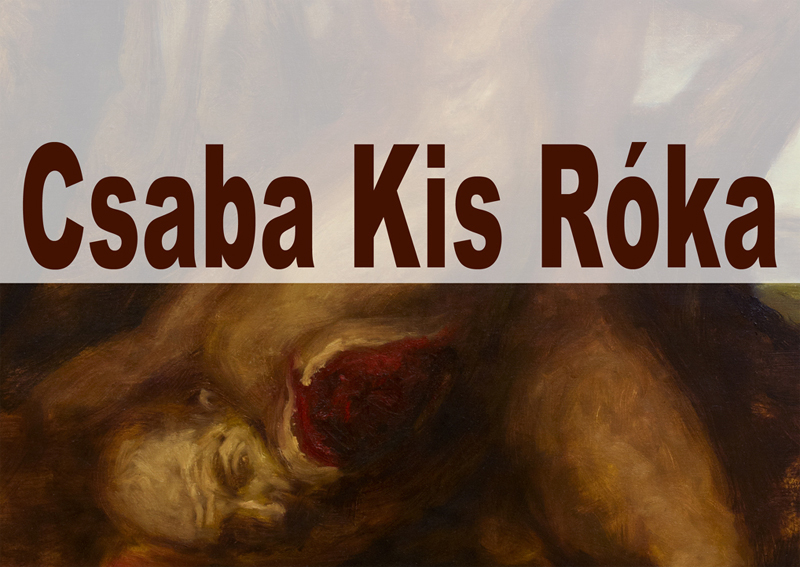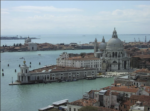Csaba Kis Róka – Symbolism Mythology and Grotesque

Kis Róka dipinge le tragedie storiche del suo est-europeo attraverso una sottile analisi di ciò che rimane nelle coscienze sociali, solitarie nel loro doversi ricostruire da un senso quasi genetico dell’inesorabilità.
Comunicato stampa
The Postmodern era is the name we attribute to that period when artists looked to the greatness of the past to find inspiration for their thinking and for revisions and revivals. Logically, such a term could not exist without the corresponding period known as Modernity. They go together like Thesis and Antithesis, a perversion in terms within a relationship of balance whose evidence is there for all to behold in the instability rife in the twenty-first century and the grey ordinariness of the latter part of the twentieth. Modernity itself is relatively recent and constitutes a pure bourgeois invention, triggered by the social revolutions of the late eighteenth century, which aspired to put man squarely in the centre of that irreversible progression, the dream that informed such a major part of the last century. It is the time of the garbage dumps.
In what is now commonly defined as a ‘culture of ignorance’, where the concept of the market no longer seems to correspond to quality, but surpasses it (today’s unequivocally post-contemporary society, drugged by the financial Utopia and by social universality), the idea of the avant-garde and of socio-political stylemes has gradually been pulverised. Many works of contemporary art – too many of them – have become no more than a sordid joke, even for a public with a more or less discerning eye for art, where the market had given rise to a new aesthetic of art and of making art.
Thus does the know-how intrinsic to man become once again a necessary connotation of artistic making.
What has really changed today compared to the Grandeur of the early twentieth-century avant-gardes? Everything and nothing… in relation to the great onward march of History, which repeats itself, as always identifying and distinguishing the great, on the one hand, from the powerless, on the other.
The avant-garde restored a voice and political and civic responsibility to almost too many artists. Ideology ruled supreme, as state-approved culture and institutions deprived the individual of that same voice. The infamous masses demand high profiles and further deleterious levellings, albeit in the direction of a liberation towards new social and professional class structures.
CSABA KIS RÓKA (Budapest, 1981) was born in a Hungarian suburb at the very time when the West was making the maximum racket as it set itself in harsh opposition while the Soviet-Bolshevik illusion crumbled. This was the first sign of the failure of a twentieth-century Utopia, which took place when the artist was a child, at the age when awareness starts to dawn. It was to take another twenty years before his country, and with it its entire cultural identity, once again took up its full and rightful place in the European system, though just in time to witness another great collapse, in 2008, when the bourgeois capitalist model based on the matrix of high finance came tumbling down, leaving Hungary in the grip of a grim neo-nationalism.
This short, purely historical introduction sketches the outlines of an artistic personality who defies fashions, coherences and the avant-gardes in general, but is bound faithfully to representing what he thinks and how he feels. And his Painting: an almost dionysiac obsession with revival that passes through loss as it is made. For Kis Róka, passion and existential expression seem to be pleasantly pre-eminent.
A magnificent painter, he combines and melds the idioms of painting tradition in its entirety, while tackling its cultural and social roots head-on, together with the topic of the disastrous Soviet Utopia as a system that erased individual personality and suffocated all and any cultural aperture towards historical and human awareness. Kis Róka paints the historical tragedies of his Eastern Europe with a subtle analysis of what has remained lodged in social consciences, left alone in having to piece themselves back together from an almost genetic sense of relentlessness.
While his figures bring typical Magyar traits to mind, the phallus represents power rather than potency and sodomy reflects the unfailing arrogance of power as it oppresses and suffocates. The Goya yellow of his sky is war and blind destruction, while sexual perversion is the inability to find an identity and accept it.
Goya and Titian are his legendary heroes. For Kis Róka, such mythology is the very stuff of his intimate, profound being, the roots from which nobody, not even the artist, can escape: to his roots go his extreme thoughts, when relentlessness arrives punctually and with certainty.
The bitter smile that conceals tears of pleasure combines together with the acceptance of suffering to brush over certain aspects of Nordic Teutonic and Eastern-European culture, in which the dimension of the grotesque basically constitutes the bitter, sarcastic ability to laugh at ourselves.
The Cahier d’Art #3 will be devoted entirely to the work of Csaba Kis Róka, accompanied by a critical essay by Márió Nemes.
Mario Casanova, 2013 [translation Pete Kercher]
SIMBOLISMO, MITOLOGIA E GROTTESCO
Csaba Kis Róka
Vernissage__sabato 13 aprile 2013 dalle 17:30
13 aprile – 9 giugno 2013 / ve-sa-do_14:00-18:00
È da considerare Epoca postmoderna quel tempo, laddove gli artisti ritrovano nella Grandezza del passato spunti di riflessione e rivisitazione; così come questo termine non esisterebbe senza quello di Modernità. Come dire Tesi e Antitesi, una perversione in termini entro un rapporto di equilibrio che trova la sua conclamazione proprio nell’instabilità del XXI secolo e nella banalità del secondo Novecento. La Modernità è relativamente recente e costituisce una pura invenzione borghese, scaturita dalle rivoluzioni sociali di fine Settecento, che vorrebbe vedere nella centralità dell’uomo quella progressiva irreversibilità, quel sogno che ha ingravidato gran parte del secolo scorso. È il tempo delle discariche.
In quella che è ormai per tutti definita una ‘cultura dell’ignoranza’, laddove il concetto di mercato non sembra più corrispondere alla qualità, ma la supera (la società odierna inequivocabilmente post-contemporanea e drogata dall’utopia finanziaria e dall’universalità sociale), l‘idea dell’avanguardia e degli stilemi socio/politici si è viepiù polverizzata. Molte, troppe opere d’arte contemporanea sono diventate una vera e propria presa in giro, anche per un pubblico più o meno avvezzo all’arte, laddove il mercato aveva dato origine ad una nuova estetica dell’arte e del fare arte.
Ecco che il ‘saper fare’ insito nell’uomo ridiventa una necessaria connotazione del ‘fare artistico’.
Cosa è realmente cambiato oggi rispetto alla ‘Grandeur’ delle avanguardie d’inizio Novecento? Tutto e niente …in rapporto alla grande Storia, che si ripete, identificando e distinguendo, come sempre, i grandi, da una parte, e gli impotenti, dall’altra.
L’avanguardia ha ridato voce e responsabilità politica e civile a finanche troppi artisti. L’ideologia diventa regime, la cultura di stato e l’istituzione toglie quella stessa voce alla ‘persona’. La famigerata massa rivendica altri profili e ulteriori deleteri livellamenti, seppure nel senso di una liberazione verso nuovi classismi sociali e professionali.
CSABA KIS RÓKA (Budapest, 1981) nasce nella periferia ungherese, nell’epoca, in cui il baccanale dell’Occidente si contrapponeva duramente allo sgretolamento dell’illusione bolscevico/sovietica; primo segnale del fallimento di un’utopia novecentesca, che avviene quando l’artista è bambino nell’età della coscienza. Ci vorranno altri vent’anni prima che il suo paese, e con sé tutta la sua identità culturale, rientrino a far parte a pieno titolo di un sistema europeo per assistere, di lì a poco, ad un’altra grande caduta; quella, nel 2008, del modello borghese capitalista di matrice finanziaria, per ritrovarsi nel pieno di un bieco neonazionalismo.
Questi pochi primi dati a carattere prettamente storico disegnano i contorni di una personalità artistica fuori dalle mode, dalle coerenze e dalle avanguardie in generale, ma fortemente legata alla rappresentazione del suo pensiero e del suo sentire. E la Pittura: un’ossessione quasi dionisiaca del recupero attraverso la perdita nel suo farsi; la passione e l’espressione esistenziale sembrano piacevolmente prioritari per Kis Róka.
Pittore magnifico, egli combina e fonde i linguaggi della tradizione pittorica, tutta, pur affrontando di petto il suo rizoma culturale e sociale, e il tema della disastrosa utopia sovietica come cancellazione della personalità e del soffocamento di qualsiasi apertura culturale alla coscienza storica e umana. Kis Róka dipinge le tragedie storiche del suo est-europeo attraverso una sottile analisi di ciò che rimane nelle coscienze sociali, solitarie nel loro doversi ricostruire da un senso quasi genetico dell’inesorabilità.
Se le figure ricordano i tipici tratti magiari, se il fallo rappresenta il potere, non già la potenza, la sodomia riflette la puntuale arroganza del potere nel sopruso e nel soffocamento. Il giallo goyesco del cielo è la guerra e la distruzione cieca, e la perversione sessuale l’incapacità di ritrovare e accettare le identità.
Goya, Tiziano sono i miti. Le mitologie sono per Kis Róka gli archetipi del suo essere intimo e profondo, le sue radici da cui nessuno, nemmeno l’artista, non può sfuggire; alle radici vanno gli estremi pensieri, quando l’inesorabile arriva sicuro e certo.
Quel riso amaro che è un pianto di piacere, l’accettazione della sofferenza lambiscono alcuni aspetti della cultura nordica teutonica e dell’est-europeo, laddove la dimensione grottesca costituisce fondamentalmente l’amara e sarcastica capacità di ridere di noi stessi.
Il Cahier d’Art #3 sarà interamente dedicato all’opera di Csaba Kis Róka con un testo critico di Márió Nemes.
Mario Casanova, 2013



